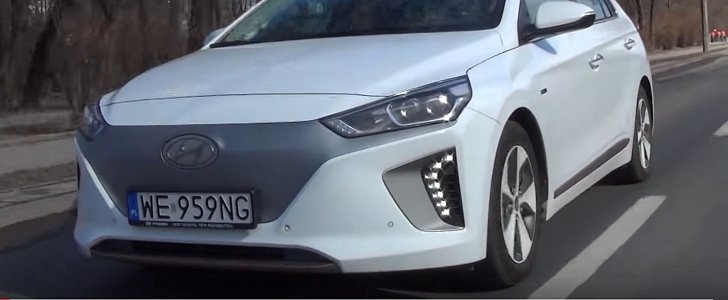The Hyundai Ioniq and Kia Niro have received mixed reviews, but there's always a disconnect between journalists' opinions and what people buy. This acceleration test with the Ioniq Electric proves the Korean automaker wants to surprise us.
If this were a review of the regular Ioniq, I could tell you how the DCT gearbox they used gives you the sensation of acceleration by dropping gears instead of whining like a CVT. But the Electric has a direct drive.
We're kind of sure that such a car could have made do with around 80 horsepower, but Hyundai chose to give it 120 hp instead. When you put your foot down hard, the wheels totally lose traction, and you will be pushed back into your seat slightly.
The Polish YouTube channel that filmed this used a V-box, so the numbers are as accurate as they come. The EV takes just 3.3 seconds from 0 to 50 km/h (31 mph), which is usually the speed limit around town. That means you'll leave most other cars behind at the lights.
Only by 100 km/h (62 mph) does the lack of power and gears start to take effect, as the Ioniq requires 9.7 seconds to get there. For the record, the official number is 9.9 seconds.
Of course, you don't buy this car for the performance, but it's nice to have it there for when you start to have those suicidal thoughts and doubt all your life choices. The rest of the time, fuel consumption isn't too bad, as you'll see in the second video from the same source.
Basically, the Ioniq gets 11.9 kWh/100km cruising at 94 km/h, which is very close to its maximum efficiency of 11.5kWh/100km. So you should b able to do 230 kilometers per charge, and not just in theory. With cruise control set to 140 km/h, the efficiency drops to 21.1 kWh/100km. But you should never drive an EV at that speed because it's very inefficient.
What's cool is that it's really up to you which Ioniq you want to buy. The EV is more expensive but comes with a torsion beam rear suspension; the hybrid is more fun, has independent suspension, is cheaper, but not very economical.
We're kind of sure that such a car could have made do with around 80 horsepower, but Hyundai chose to give it 120 hp instead. When you put your foot down hard, the wheels totally lose traction, and you will be pushed back into your seat slightly.
The Polish YouTube channel that filmed this used a V-box, so the numbers are as accurate as they come. The EV takes just 3.3 seconds from 0 to 50 km/h (31 mph), which is usually the speed limit around town. That means you'll leave most other cars behind at the lights.
Only by 100 km/h (62 mph) does the lack of power and gears start to take effect, as the Ioniq requires 9.7 seconds to get there. For the record, the official number is 9.9 seconds.
Of course, you don't buy this car for the performance, but it's nice to have it there for when you start to have those suicidal thoughts and doubt all your life choices. The rest of the time, fuel consumption isn't too bad, as you'll see in the second video from the same source.
Basically, the Ioniq gets 11.9 kWh/100km cruising at 94 km/h, which is very close to its maximum efficiency of 11.5kWh/100km. So you should b able to do 230 kilometers per charge, and not just in theory. With cruise control set to 140 km/h, the efficiency drops to 21.1 kWh/100km. But you should never drive an EV at that speed because it's very inefficient.
What's cool is that it's really up to you which Ioniq you want to buy. The EV is more expensive but comes with a torsion beam rear suspension; the hybrid is more fun, has independent suspension, is cheaper, but not very economical.




























